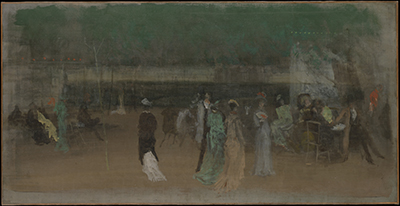This piece of work was done by James Abbott McNeil Whistler during his artwork duration between 1870 to 1880. Cremorne gardens no.2 piece of art is painted from American culture.
James Whistler painted this art on a piece of canvas of length 134.9 cm and width 68.6 cm using oil and paintings. The painting colors brought out a brilliant and luxurious garden outlook. Thereafter, this art was credited by John Stewart Kennedy fund in the year 1912 and later presented in North and Central America as well as the United States. The art is an elegant drawing of a park of which during the day has a magnificent stroller and in the night, it turns into a music and dancing site with fireworks where people of different social classes gathered. The painting contains active figures which are very fashionable. These active figures include chairs, people and trees.
Although most of James work was mostly from a musical and poetic base, he got the inspiration to draw this piece of art from the modern life of the Europeans associates and more of it from his French associates Manet and Tissot. James also lived in Cheyne Walm which is just a few meters away from Cremorne gardens where he loved visiting and hanging out. For this reason, he had a better view of what he was to paint. The piece of art was later owned by Thomas Way (James Abbott son) from 1879 to 1905. After some time, Alexander Arnold Hannay owned it and later sold it to Percy M. Turner.
Later, this art was cleaned to bring out a clear picture with accurate color combinations and high-quality presentation to improve its reselling rate but some feature was omitted which made Bryson Burroughs term it an unfinished piece of art. It was later reproduced and still did not contain the omitted feature and for this reason, the art became more suggestive than descriptive. It satisfied the standard of all worldwide museums and galleries and today it is owned by the museums from 1912.




